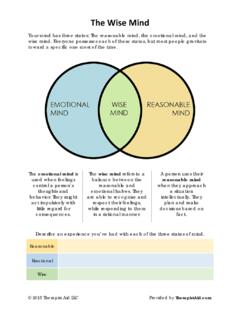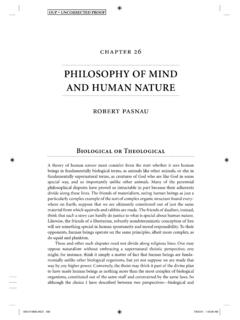Transcription of Neuroscience of Learning An Introduction to Mind, Brain ...
1 Neuroscience of Learning An Introduction to mind , Brain , Health, and Education Section: neurotransmitters Harvard University Extension School (PSYCE-1609). February 2, 2016. Spring, 2016 1. Spring, 2016 2. Spring, 2016 3. Which of these is a neuron? Spring, 2016 4. Which of these is a neuron? All of them! Spring, 2016 5. What is the neuron doctrine? Spring, 2016 6. The Neuron Doctrine Santiago Ramon y Cajal Chick cerebellum neurons drawing by Ramon y Cajal (1905). Key tenet: Neurons are specialized Brain cells that are not continuous, but contiguous ( , there is a gap/transmission barrier between neurons).
2 Spring, 2016 7. 2. Neurons connect via a synapse Spring, 2016 8. Where's the synapse? Spring, 2016 9. Where's the synapse? Spring, 2016 10. Name that anatomy . Spring, 2016 11. Name that anatomy . Axonal bouton =. Pre-synaptic terminal Spring, 2016 12. Name that anatomy . Spring, 2016 13. Name that anatomy . Dendrite =. Post-synaptic terminal Spring, 2016 14. Name that anatomy . Spring, 2016 15. Name that anatomy . Synaptic Vesicles Spring, 2016 16. What's inside synaptic vesicles? Synaptic Vesicles Spring, 2016 17. neurotransmitters Spring, 2016 18. Are we making new vesicles all the time? Spring, 2016 19.
3 Synaptic vesicles are constantly emptied, recycled, and refilled Spring, 2016 20. Where does all the NT go? Spring, 2016 21. Reuptake, Diffusion, Metabolism A lot of NTs are taken back into the vesicles for reuse Some breakdown Some diffuse Spring, 2016 22. How do neurons fire? . Spring, 2016 23. Triggering an Action Potential = Firing Dendrites are triggered by a neighboring axon Spring, 2016 24. Triggering an Action Potential = Firing The cell body collects all the triggers from the dendrites Dendrites are triggered by a neighboring axon Spring, 2016 25. Triggering an Action Potential = Firing Axon Hillock The cell body collects all the triggers from the dendrites If enough input is collected, the cell body triggers the axon to Dendrites are triggered by a transmit the signal to all neighboring axon connected neurons Spring, 2016 26.
4 How does summation happen? Why does it need to? Spring, 2016 27. Because neurons receive both excitatory and inhibitory input ;. Spring, 2016 28. What is the end result of a neuron firing? Spring, 2016 29. What is the end result of a neuron firing? Neurotransmitter release Spring, 2016 30. Ionotropic: NT binds to the ion channel Spring, 2016 31. Metabotropic: NT binding opens ion channels Spring, 2016 32. How much is being released? All of the vesicles within a neuron contain about the same amount of NT. Spring, 2016 33. How much is being released? All of the vesicles within a neuron contain about the same amount of NT.
5 CNS synapses typically release one vesicle per action potential Spring, 2016 34. How much is being released? All of the vesicles within a neuron contain about the same amount of NT. CNS synapses typically release one vesicle per action potential Neuromuscular synapses release about 200 vesicles per action potential Spring, 2016 35. How much is being released? Why do muscles get more? Spring, 2016 36. How much is being released? Why do muscles get more? As a fail-safe to make sure muscles can contract Spring, 2016 37. Poll: What influences NT levels? Spring, 2016 38. neurotransmitters have different jobs Spring, 2016 39.
6 What if blocking a certain neurotransmitter caused muscle paralysis? What would you guess about it's function? Spring, 2016 40. Botulism: Acetylcholine vesicles can't release Botulism causes paralysis because it prevents the release of acetylcholine (necessary for muscle contraction). Spring, 2016 41. Acetylcholine (excitatory). Stimulates muscle contraction Stimulates release of some hormones Helps regulate lots of things including: Wakefulness Attention/vigilance Anger Aggression Sexual drive Thirst Learning /memory Spring, 2016 42. Acetylcholine (excitatory). Alcohol decreases acetylcholine transmission Spring, 2016 43.
7 What if blocking a certain neurotransmitter caused muscle spasms? What would you guess about it's function? Spring, 2016 44. Tetanus: GABA vesicles can't release Tetanus causes muscle spasm because it prevents the release of GABA which inhibits muscular contraction the muscles never stop contracting Muscle spasms in a person with tetanus. Painting by Sir Charles Bell, 1809. Retrieved from Spring, 2016 45. GABA (inhibitory). Works throughout the Brain to balance excitatory NTs o About 40% of neurons have GABA receptors o Most active inhibitory NT. Synthesized from glutamate (the major excitatory NT). Essential for: o Motor control (refines movement).
8 O Vision o Anxiety regulation Spring, 2016 46. What would happen to GABA levels if glutamate levels decreased? Spring, 2016 47. What would happen to GABA levels if glutamate levels decreased? They would decrease Spring, 2016 48. neurotransmitters influence each other Spring, 2016 49. If you alter the levels of one, the others will adjust in response Neurotransmitter Mobile Spring, 2016 50. If you alter the levels of one, the others will adjust in response Neurotransmitter Mobile Spring, 2016 51. If you alter the levels of one, the others will adjust in response Neurotransmitter Mobile Spring, 2016 52. Glutamate (excitatory).
9 Works throughout the Brain Involved in most cognitive functions, especially Learning and memory Critical agent for long-term potentiation (Hebbian Learning ). Spring, 2016 Vance (2014) 53. Glutamate (excitatory). Actions (at NMDA glutaminergic receptors) can be blocked by alcohol Spring, 2016 Vance (2014) 54. Glutamate (excitatory). Actions (at NMDA glutaminergic receptors) can be blocked by alcohol St. John's Wort can increase release Spring, 2016 Vance (2014) 55. If you want to learn better, should you take lots of St. John's Wort so you increase your glutamate levels? Spring, 2016 56. Too much glutamate is a bad thing Spring, 2016 57.
10 57. Do genes influence NT levels? Spring, 2016 58. Genes can influence NT levels/processing ADHD gene reduces dopamine release in dorsal striatum Gene associated with depression and suicide decreases noradrenergic transmission Adolescent binge drinking alters adult gene expression resulting in decreased cholinergic neuron density Coleman (2011), Kim (2014), Sanchez-Mora (2013). Spring, 2016 59. Do lifestyle choices influence NT levels? Spring, 2016 60. Lifestyle factors can influence NT levels Nicotine blocks cholinergic receptors Spring, 2016 61. Lifestyle factors can influence NT levels Exercise: o Attenuated dopamine depletion o Increased serotonin and Ach levels Enriched environment o Upregulates genes that balance NT activity Diet: o One-week of high-fat/low-carb diet decreased serotonin levels in the hypothalamus o Consuming fat/sugar combinations reduced dopamine signaling o Long-term consumption of low-protein/high-carb diet decreased dopaminergic receptor density Spring, 2016 Kramer (2006), Lee (2013), Lopresti (2013) 62.
















